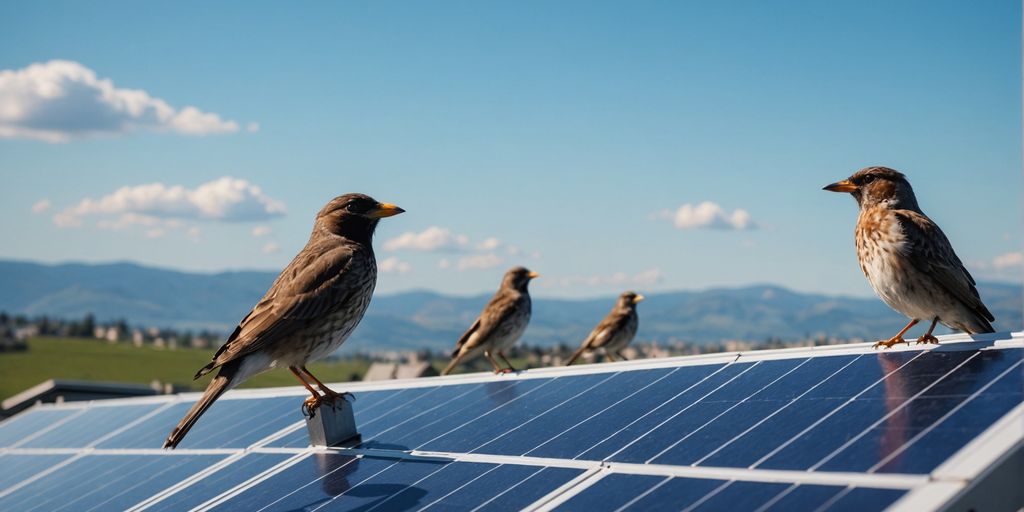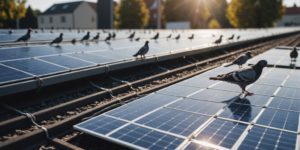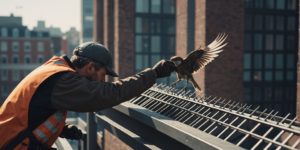Solar panels are an increasingly popular source of renewable energy, but they come with their own set of challenges, particularly when it comes to birds. Birds are often attracted to solar panels for various reasons, which can lead to damage and health risks. This article explores the reasons behind this attraction, the potential damage caused, and effective methods to protect solar panels from birds.
Key Takeaways
- Birds are attracted to solar panels due to their reflective surfaces, warmth, and shelter opportunities.
- Bird droppings and nesting debris can significantly reduce the efficiency of solar panels by blocking sunlight.
- Regular cleaning and maintenance are essential to mitigate the damage caused by birds to solar panels.
- There are various bird-proofing methods available, including installing bird mesh and using fake birds of prey.
- Legal and ethical considerations must be taken into account when implementing bird deterrent measures to ensure compliance with wildlife protection laws.
Understanding the Attraction of Birds to Solar Panels
Birds are often drawn to solar panels for several reasons, making them a common sight around these installations. Reflective surfaces and the warmth provided by the panels are significant factors in this attraction. Additionally, the shelter and nesting opportunities that solar panels offer make them an ideal spot for birds to settle.
Reflective Surfaces and Bird Behavior
The reflective surfaces of solar panels can captivate birds, much like windows do. This reflection can make the panels appear as a safe and attractive place to land. Birds, especially pigeons, are known to be drawn to these shiny surfaces, leading to the common question: Do Solar Panels Attract Pigeons? The answer is yes, largely due to the reflective nature of the panels.
Shelter and Nesting Opportunities
Solar panels provide a large, sheltered area that protects birds from harsh weather conditions and predators. This makes them an excellent spot for nesting. Birds often find the space beneath the panels to be a safe haven for raising their young, further increasing their attraction to these installations.
Heat and Warmth Provided by Panels
The heat generated by solar panels is another key factor that attracts birds. The warmth under the panels offers a comfortable environment, especially during colder months. This warmth, combined with the shelter provided, makes solar panels an appealing nesting site for birds.
Potential Damage Caused by Birds to Solar Panels
Pecking and Scratching of Panels
Birds can cause significant damage to solar panels by pecking at the wiring or scratching the surface. This can lead to reduced efficiency or even malfunction of the panels. Regular maintenance and cleaning can help prevent and mitigate any potential damage caused by birds.
Accumulation of Droppings
Bird droppings can accumulate on the panels, reducing their ability to absorb sunlight and produce electricity. The droppings are also acidic, which can lead to surface corrosion over time. This not only affects the efficiency of the panels but can also cause long-term damage.
Nesting Debris and Its Impact
Birds often build nests under solar panels, leaving behind broken eggs, dead chicks, and other debris. This accumulation can reduce the airflow needed to prevent the panels from overheating, posing a fire hazard. Additionally, the presence of nesting materials can attract other pests, leading to further complications.
It’s essential to inspect your solar panels regularly to ensure they are free from bird-related debris and damage. This proactive approach can save you from costly repairs and maintain the efficiency of your solar energy system.
Health Risks Associated with Bird Droppings on Solar Panels
Diseases Carried by Bird Droppings
Bird droppings are not just an eyesore; they can carry over 60 dangerous illnesses. These pathogens can be harmful and, in some cases, even fatal. The accumulation of droppings on solar panels can lead to serious health issues if not addressed promptly.
Impact on Human Health
The presence of bird droppings on solar panels can pose significant health risks to humans. Bird mess can cause blockages, leading to unpleasant smells and potential damage to your roof. Moreover, the acidic nature of the droppings can corrode surfaces, further exacerbating the problem.
Preventive Measures
To mitigate the health risks associated with bird droppings, regular maintenance and cleaning of solar panels are essential. Here are some preventive measures:
- Install bird mesh: This can prevent birds from nesting under the panels.
- Use fake birds of prey: These can deter birds from approaching the solar panels.
- Regular inspections: Ensure that any accumulation of droppings is promptly cleaned to avoid health hazards.
Regular inspection is essential to protect your panels from loss or damage due to unpredictable weather conditions. Bird droppings falling from the sky can also cause damage to the panels. Bird droppings may cause corrosion and structural damage on solar panels. It is therefore recommended that you get an insect guard on your solar panels.
Methods to Protect Solar Panels from Birds
Protecting solar panels from birds is essential to maintain their efficiency and longevity. Here are some effective methods to keep birds away from your solar panels.
Installing Bird Mesh
Securing wire mesh to the edges of solar panels can effectively stop birds nesting under solar panels. This method not only prevents birds from accessing the area but also keeps debris from accumulating. Professional installation is recommended due to the complexity of accessing rooftop solar panels.
Using Fake Birds of Prey
Placing decoys of predators, such as owls or hawks, around your property can deter birds from approaching. This humane and cost-effective method can be particularly useful in residential areas. However, it may not be effective if birds have already established nests.
Regular Cleaning and Maintenance
Routine cleaning and maintenance are crucial to ensure the effectiveness of bird-proofing measures. Regular inspections can help identify and address any issues promptly, ensuring that your solar panels remain in optimal condition. Critter Guard Solar Cost can be minimized by combining DIY methods with professional services.
Consistent maintenance and the use of protective measures can significantly extend the lifespan of your solar panels, ensuring they remain efficient and free from bird-related damage.
Legal Considerations in Bird Proofing Solar Panels
When implementing bird-proofing measures for solar panels, it’s crucial to navigate the legal landscape to ensure compliance and ethical practices. Understanding the legal framework can help avoid potential fines and ensure that bird deterrence methods are humane and effective.
Cost-Effective Solutions for Bird Proofing
Bird proofing your solar panels doesn’t have to break the bank. There are several cost-effective methods to keep birds at bay and protect your investment. Here are some practical solutions to consider:
DIY Methods
For those who prefer a hands-on approach, DIY methods can be both effective and budget-friendly. Installing a solar panel system bird net for rooftop solar PV systems can keep debris and pests away. Available for $500.00, this netting solution is easy to install and maintain. Additionally, using anti bird wire can create a physical barrier that prevents birds from landing on your panels.
Professional Services
If DIY isn’t your style, hiring a professional Pigeon Removal Service can be a worthwhile investment. Companies like Goldshot Exterminating offer specialized services to ensure your solar panels remain bird-free. While the Bird Spike Installation Cost may vary, professional services often provide a more permanent solution.
Long-term Benefits
Investing in bird proofing measures not only protects your solar panels but also ensures their longevity and efficiency. By preventing birds from nesting and causing damage, you can avoid costly repairs and maintain optimal energy production.
Regular maintenance and timely interventions can save you from expensive repairs in the long run. It’s always better to be proactive than reactive when it comes to protecting your solar panels.
In summary, whether you choose DIY methods or professional services, there are several cost-effective solutions to keep your solar panels bird-free. The key is to find a method that suits your budget and needs, ensuring long-term benefits for your solar investment.
Case Studies: Successful Bird Proofing of Solar Panels
Residential Installations
In a residential area in Nevada, homeowners faced significant issues with birds nesting under their solar panels. They opted for a combination of Solar Panel Clips and wire mesh to secure the perimeter of their panels. This solution effectively prevented birds from accessing the underside of the panels, thereby eliminating nesting opportunities and reducing debris accumulation.
Commercial Installations
A commercial building in California experienced frequent bird-related problems, including droppings and nesting debris affecting the efficiency of their solar panels. The facility management decided to install Solar Trim and Defender Solar Panels. This approach not only deterred birds but also enhanced the overall rust resistance of the solar array. The result was a significant improvement in the system’s performance and longevity.
Lessons Learned
- Regular Maintenance: Consistent cleaning and inspection are crucial to ensure the effectiveness of bird-proofing measures.
- Professional Installation: Hiring experts for the installation of bird deterrents like Solar Panel Clips and Solar Trim can prevent potential damage to the panels.
- Customized Solutions: Tailoring the bird-proofing methods to the specific needs of the installation site yields the best results.
Implementing bird-proofing measures not only protects the solar panels but also ensures their optimal performance and longevity.
Innovative Technologies in Bird Deterrence
Advanced Mesh Designs
Advanced mesh designs are becoming increasingly popular for protecting solar panels from birds. These meshes are designed to be more durable and effective than traditional options, providing a long-lasting solution to bird-related issues. The mesh can be easily installed around the panels, creating a barrier that prevents birds from accessing the area beneath the panels. This method is particularly effective when combined with other deterrents, such as spikes or visual deterrents.
Ultrasonic Bird Repellents
Ultrasonic bird repellents are another innovative technology being used to protect solar panels. These devices emit high-frequency sounds that are unpleasant to birds but inaudible to humans. The sound waves create an environment that birds find uncomfortable, encouraging them to stay away from the solar panels. Ultrasonic repellents are a humane and eco-friendly option, as they do not harm the birds but simply deter them from the area.
Solar Panel Modifications
Modifying solar panels to make them less attractive to birds is another approach being explored. This can include adding reflective surfaces or coatings that birds find unappealing. Additionally, some companies are developing solar panels with built-in bird deterrents, such as integrated spikes or Natural Bird Deterrents. These modifications can help reduce the likelihood of birds nesting or perching on the panels, thereby minimizing potential damage and maintenance issues.
By integrating these innovative technologies, solar panel owners can effectively protect their investments while adhering to wildlife protection guidelines.
Bird Deterrent Speaker
Bird deterrent speakers are another effective method for keeping birds away from solar panels. These speakers play recorded sounds of predators or distress calls of birds, creating an environment that birds perceive as dangerous. The Bird Deterrent Speaker can be programmed to play sounds at random intervals, preventing birds from becoming accustomed to the noise. This method is particularly useful in areas with high bird activity, as it provides a continuous deterrent without causing harm to the birds.
Environmental Impact of Bird Proofing Measures

Balancing Bird Safety and Solar Efficiency
Implementing bird proofing measures for solar panels requires a delicate balance between protecting birds and maintaining the efficiency of the solar energy system. Effective bird proofing can prevent birds from nesting and causing damage, but it must be done in a way that does not significantly impact the performance of the solar panels. For instance, using bird mesh can be a practical solution, but it must be designed to withstand various weather conditions to ensure long-term effectiveness.
Sustainable Bird Deterrence
Sustainable bird deterrence methods are essential to minimize the environmental impact. These methods include using non-toxic materials and ensuring that the deterrents do not harm the birds. For example, installing fake birds of prey can be a humane and cost-effective way to deter birds without causing them harm. Additionally, regular maintenance and cleaning of the solar panels can help keep them in optimal condition while ensuring that bird deterrence measures remain effective.
Community Involvement in Bird Protection
Community involvement plays a crucial role in the success of bird proofing measures. Educating the public about the importance of protecting both the solar panels and the local bird population can lead to more effective and widely accepted solutions. Community-driven initiatives, such as local wildlife protection programs, can help ensure that bird proofing measures are implemented ethically and in compliance with local regulations.
By involving the community in bird protection efforts, we can create a more sustainable and harmonious environment for both humans and wildlife.
Maintenance Tips for Bird-Proofed Solar Panels
Routine Inspections
Regular inspections are crucial to ensure the longevity and efficiency of your bird-proofed solar panels. It’s essential to check for any signs of damage or wear on the bird-proofing materials, such as the Solar Panel Mesh Clips or the Squirrel Screen Guard. These inspections should be scheduled at least twice a year, ideally before and after the bird nesting season.
Cleaning Techniques
Keeping your solar panels clean is vital for maintaining their efficiency. Bird droppings and debris can accumulate, reducing the panels’ ability to absorb sunlight. Use a soft brush or a hose with a gentle stream of water to clean the panels. Avoid harsh chemicals that could damage the Solar Panel Mesh Wire Clip or other protective materials. For best results, clean your panels early in the morning or late in the evening when they are cool.
Monitoring and Adjustments
Consistent monitoring of your solar panel system can help identify potential issues before they become significant problems. Utilize monitoring software to track the performance of your panels. If you notice a drop in efficiency, it may be due to bird-related debris or damage. In such cases, inspect the bird-proofing measures and make necessary adjustments or repairs.
Regular maintenance not only ensures the efficiency of your solar panels but also extends their lifespan, protecting your investment in clean energy.
By following these maintenance tips, you can keep your solar panels in optimal condition while effectively deterring birds.
Maintaining your bird-proofed solar panels is essential for optimal performance and longevity. Regular cleaning and inspections can prevent debris buildup and ensure maximum energy efficiency. For more detailed maintenance tips and professional services, visit our website today!
Conclusion
In conclusion, while solar panels offer numerous environmental and economic benefits, they also present challenges related to bird interactions. Birds are often attracted to the warmth and shelter provided by solar panels, which can lead to nesting and potential damage. Effective bird-proofing measures, such as installing mesh, using fake birds of prey, and regular cleaning, are essential to protect both the solar panels and the birds. By implementing these strategies, homeowners can ensure the longevity and efficiency of their solar panel systems while also safeguarding local wildlife. As the adoption of solar energy continues to grow, it is crucial to address these challenges proactively to create a harmonious coexistence between renewable energy infrastructure and the natural environment.
Frequently Asked Questions
Why are birds attracted to solar panels?
Birds are attracted to solar panels due to their reflective surfaces, which can appear like water or open sky to birds. Additionally, the panels provide warmth, shelter, and nesting opportunities, making them an ideal spot for birds to settle.
Can birds damage solar panels?
Yes, birds can cause damage to solar panels. They may peck at the wiring or scratch the surface of the panels, reducing their efficiency. Bird droppings and nesting debris can also accumulate, blocking sunlight and potentially causing overheating.
What are the health risks associated with bird droppings on solar panels?
Bird droppings can carry over 60 diseases, some of which can be harmful to humans. Accumulated droppings can also corrode the panels and affect their structural integrity. Regular cleaning and maintenance are essential to mitigate these risks.
What methods can be used to protect solar panels from birds?
There are several methods to protect solar panels from birds, including installing bird mesh, using fake birds of prey, and conducting regular cleaning and maintenance. These measures help deter birds from nesting and causing damage.
Are there legal considerations when bird-proofing solar panels?
Yes, there are legal considerations. Wildlife protection laws prohibit harming birds or disturbing their nests. It is essential to use ethical bird deterrence methods and comply with local regulations when bird-proofing solar panels.
Is it cost-effective to bird-proof solar panels?
Yes, bird-proofing solar panels can be cost-effective in the long run. DIY methods, professional services, and innovative technologies can help protect your investment, reduce maintenance costs, and ensure the efficiency of your solar panels.
What are some innovative technologies in bird deterrence for solar panels?
Innovative technologies in bird deterrence include advanced mesh designs, ultrasonic bird repellents, and modifications to solar panels that make them less attractive to birds. These technologies provide effective and sustainable solutions for bird-proofing.
How often should solar panels be cleaned to prevent bird-related issues?
Solar panels should be cleaned at least once a year to prevent the accumulation of dirt, bird droppings, and nesting debris. Regular inspections and maintenance help ensure the panels operate efficiently and prolong their lifespan.



